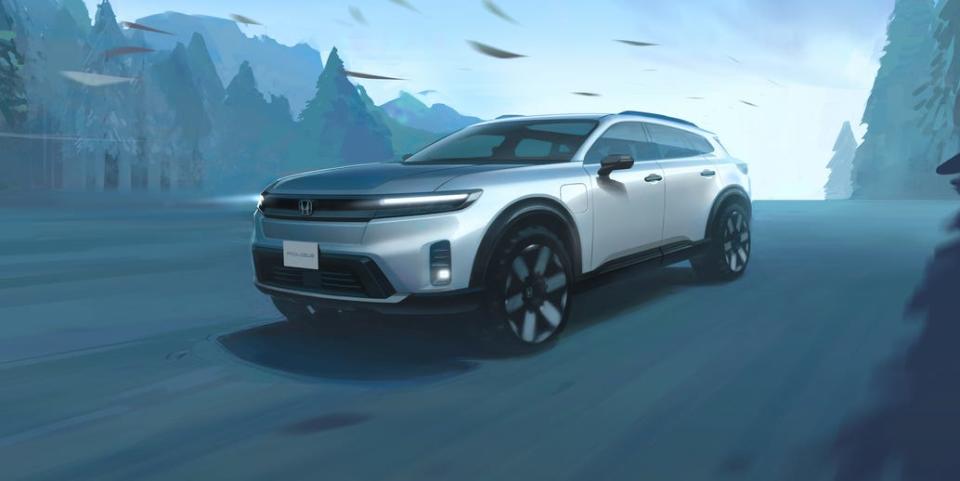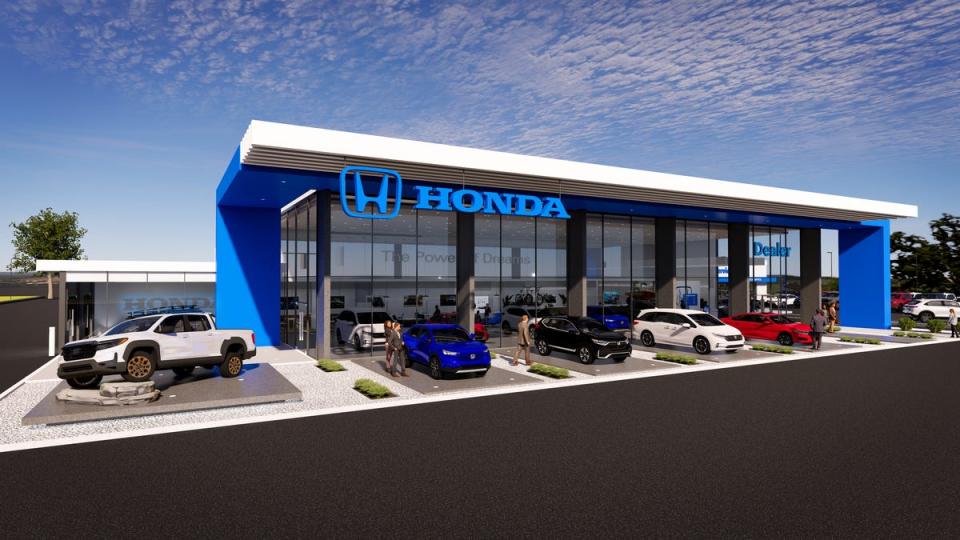Honda Unveils Neo-Rugged Prologue EV Concept

Honda releases a rendering of its new "neo-rugged" Prologue EV concept, complete with off-road capable tires and a wide footprint.
Continuing its partnership with General Motors, Honda confirms an additional set of compact EV crossovers will be available by 2027, in addition to its own e: Architecture offerings.
The company will take a regional and regulation-informed approach to EV sales with newly designed showroom layouts available to high demand dealerships.
Knobby tires, a thin front fascia, and long wheelbase stylize Honda’s new Prologue EV SUV in a new teaser rendering. A hint of Honda’s overseas E architecture blends with the boxy but soft shapes popularized by the Pilot and Passport SUVs to create the new Ultium battery-platformed SUV.
“The exterior styling of the Prologue represents the clean, simple and timeless values of the global Honda design direction, together with a long wheelbase, shorter overhang and a strong stance outfitted with a capable tire,” Honda said. “The team also focused on aerodynamics, fine-tuning the body with a simple surface direction and fewer lines to improve range and reduce cabin noise.”
Co-development with General Motors has allowed Honda to minimize development costs in a move they say will ultimately lower the cost of entry for prospective EV buyers. Honda has yet to release any pricing or mechanical specifications for the new Prologue, though the model will fit within the brand's midsize SUV category. With a release date of 2024, Honda’s Prologue is set to be the first North American BEV offering since the Honda Clarity EV, which ceased production in 2020.
Using GM’s 200-kWh Ultium skateboard architecture may offer up to 400 miles of range for the Prologue. As other automakers continue their EV development programs, range and charging capacity will define the segment, with the Ultium platform optimized for Level 2 and DC fast charging. A potential charge rate of 100 miles every 10 minutes, as demonstrated on the Hummer EV, could set up Honda’s new EV for success.
Honda has generally maintained strong footing despite inventory issues and a slow first quarter. Capitalizing on its ever-strong CR-V and HR-V sales, spokesperson Jessica Fini said Honda is calling 2022 the year of the SUV, concurrently redesigning top-selling models and introducing a hybrid version of the CR-V. Using the energy of its traditionally successful models, Honda aims to ease consumers into electrification. Following the release of a hybrid CR-V this year, an Accord hybrid is set to release for the 2024 model year and a Civic hybrid will follow.
It’s true Honda is currently offering BEVs overseas, with the e:NS1 and e:NP1 crossovers available in China, but the manufacturer's plan for North America remains staggered. Following the launch of the Prologue in 2024, Honda will launch BEVs in North America using the same e: model framework in 2026. Honda did not disclose the body style of the proprietary EVs, nor the figures for how many North American offerings are planned within the 30 global EVs the company plans to produce.
One year later, Honda plans to release a series of battery-electric compact crossovers, which will also be co-produced with GM. As outlined, Honda expects this rollout will sell 500,000 EVs in North America by 2030. North American market vehicles will be produced in North America, the company confirmed.
Honda is taking a different path to electrification in North America, relative to its peers. Companies like Ford and Nissan plow ahead with in-house BEV development while Honda’s plan rests on shared production with GM and hybrid acceptance. When asked why Honda will focus on PHEV models before BEVs, Vice President of Auto Sales Mamadou Diallo explained, “I think the hybrid electric strategy is a critical pathway for Honda’s strategy when it comes to reducing our greenhouse gas emissions.”
Honda believes those who adopt hybrid models will then become the first BEV customers. By adding hybrid options for the most popular models, Honda says it can see hybrids accounting for 50% of sales in the coming years. And beyond the hybrids, Honda expects to sell a total of 300,000 EVs globally by 2026, the year in which Honda will begin introducing its own line of BEVs.

Consumer demand is what Honda hopes will drive increased sales for the impending EV lineup, though the reality is that regional and federal regulations will play as much—if not more—of a role in the production of these cars. For example, 13 states have currently adopted the federal Zero Emissions Vehicle (ZEV) program with more states expected to join by 2027. ZEV operates on a credit system, meaning OEMs are required to sell a certain portion of zero-emission vehicles in relation to their non-electric sales. As a result, Honda won’t be the only manufacturer competing for EV sales in these states.
Honda realizes its dealerships will play a big part in meeting the sales targets. In fact, Honda has introduced an entirely new dealership concept designed specifically for EV sales. “A new dealership facility design provides dealers with a modular and flexible space reflecting changes in the way customers shop for and purchase vehicles, as well as lower inventory dealers will need to support sales in the future,” Honda said, clarifying that charging stations will be allocated on the basis of EV sales volume through 2030.
As Honda starts its newest push into the EV marketplace, the plug-in hybrid to battery power pipeline is a tactic to watch closely. Though the plan has raised more than a few suspicions, Honda has long adopted electric technology, citing the Insight hybrid, and isn’t entering the space blind. Backed by GM and with understanding gained from overseas EV launches, Honda could be on the right track.
Like it or not, SUVs and crossovers continue to demand market space in North America. What we’re really looking forward to, however, are true compact models like the now dead Honda Fit. With 30 EVs enroute, let’s hope Honda funnels some smaller, fun models our way.

 Yahoo Autos
Yahoo Autos 